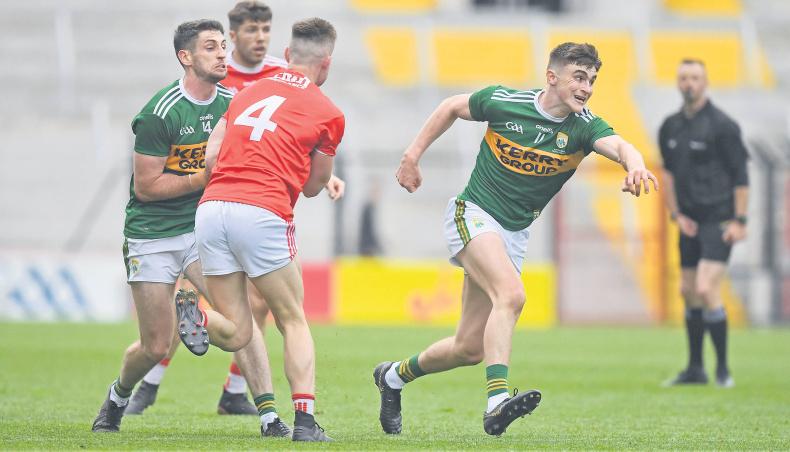Is it cruel to say that, now the provincial championships are out of the way, we can enjoy the proper cut-and-thrust of the football championship? Or is it all facile anyway as we coast towards another Dublin victory, with everyone else just battling for places on the grid?
Last weekend saw the Connacht, Leinster and Munster finals take place and all went to the script, with only the Kerry-Cork game threatening an upset. Three points separated the teams in that, while the gap was five in the Ulster decider between Donegal and Cavan on Sunday, though the Breffni County’s second goal came at the death and it never felt as if Declan Bonner’s side would be denied.
Sunday’s second game was of course the Leinster final between Dublin and Meath and perhaps the biggest surprise was the odd half-time scoreline of 0-5 to 0-1, especially as Meath had had chances in that opening period only to squander them. Pretty much as expected, Dublin powered on to take victory by 1-17 to 0-4.
It meant nine in a row for the Dubs in Leinster and 14 titles in 15 years, with the semi-final loss to Meath in 2010 their only provincial defeat since 2004. Obviously, the quality of Jim Gavin’s team is unquestionable and the lack of complacency shown over the past five years is incredible, considering how it’s possible to be tripped up.
They are so dominant that they are accused of being boring, which is really the ultimate back-handed compliment, that you are so good that you are practically unbeatable.
Dublin are at that level, but the elephant in the room is the huge disparity in terms of funding received. Between 2007 and 2018, the county received nearly €18m in grants (Cork were second over that period with €1.4m), and a commercial earning power that dwarfs everybody else.
GAA President John Horan was asked about the lopsided nature of the funding earlier this week but he doesn’t foresee a radical revision.
“I’m not going to say it’s on the agenda,” he said. “I think it is moving in a progressive way. More money is going into counties outside of Dublin.
“One other factor in all of this is local councils outside of Dublin actually provide funding for coaching structures which Dublin doesn’t benefit from.
“Just because it doesn’t come into the equation of the GAA figures, it is not accounted for. Most of the counties within Leinster are getting funding from the local councils towards a coaching project. That is a balancing factor in it and is never taken into account when the figures are published.”
To that end, we can expect more of the same, with everybody else hoping for the occasional slip-up, though under the current system it’s possible for a team to lose once in the provincial championship and again in the Super 8 and still advance to the All-Ireland semi-finals.
Saturday evening’s Munster final in Páirc Uí Chaoimh wasn’t expected to be the closest tussle of the four provincial finals, but Cork confounded the low expectations and in many ways will be left feeling that they missed an opportunity.
There were certainly misgivings among the Rebel faithful regarding the performance of referee Anthony Nolan but he did still send off Kerry’s Paul Geaney and Cork were unable to take advantage of the extra man.
Though the gap was brought down to a point near the end, Kerry pushed on again, showing that greater bit of nous, but it was an encouraging Cork display, considering the same game a year ago resulted in a 17-point hammering.
The challenge now for Cork is to show that Saturday wasn’t just a case of lifting themselves for one big game, with a tough qualifier tie the weekend after next for a place in the Super 8.
Opposing the four beaten provincial finalists will be the four winners of this weekend’s round three qualifier ties and it will be interesting to see what kind of a bounce Armagh get from their win over Monaghan as they go to Castlebar to face Mayo.
Likewise, the Kildare-Tyrone clash will be an interesting one and the Westmeath-Clare and Laois-Offaly games afford the winners a great chance of the Super 8, especially as they will be coming in to the fourth round with momentum behind them. Let the real stuff begin! CL
Womens World Cup heating up
The ‘real stuff’ is also under way in the Women’s World Cup, with Friday night’s quarter-final between hosts France and the United States, who are favourites, having the potential to be one of the games of the tournament.
As previously mentioned, the ease of access to coverage is one of the things making the competition such a success and RTÉ and TG4 deserve great credit for taking the decision to broadcast the matches as it wasn’t a cast-iron guarantee that the tournament would be a draw for viewers.
They have backed up the action with proper analysis and are being rewarded. It does certainly feel like the beginning of a redressing of the imbalance that exists with the men’s game.
However, if television can be said to be the making of the Women’s World Cup, it’s also threatening to be the undoing of it, in the form of video assistant refereeing (VAR).
Introduced for the men’s tournament last summer, it became more prevalent in the Champions League over the winter and spring and it is now almost ubiquitous in the women’s games.
The pedantry has been upped a notch or two though, with decisions taking longer and the margins ever more minimal.
The idea is sound in theory, but it certainly needs refinement before we end up with games being held up every five minutes.






 This is a subscriber-only article
This is a subscriber-only article









SHARING OPTIONS: